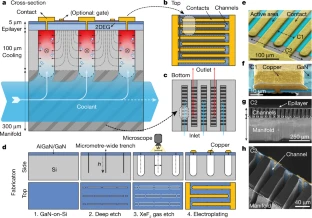Co-design of electronics with microfluidics for more sustainable cooling
Thermal management is one of the most important challenges for the future of electronics. With the steadily increasing data generation and communication rate as well as the constant urge to reduce the size and cost of industrial converter systems, the power density of electronics has increased. As a result, cooling, with its enormous energy and water consumption, is having an ever greater impact on the environment, and new technologies are needed to generate heat in a more sustainable way - that is, using less water and energy. Embedding the liquid cooling directly into the chip is a promising approach for more efficient thermal management. However, even with the most modern approaches, electronics and cooling are treated separately, so that the full energy-saving potential of the embedded cooling remains unused.

Co-designed microfluidically cooled electrical device
Source image: Nature 585, 211-216 (2020)
Here, the researchers show that by co-designing microfluidics and electronics within the same semiconductor substrate, they can produce a monolithically integrated, diverse microchannel cooling structure with an efficiency that exceeds what is currently available. Their results show that heat flows of more than 1,7 kilowatts per square centimeter can be dissipated with a pump output of only 0,57 watts per square centimeter. They observed an unprecedented coefficient of performance (over 10.000) for single-phase water cooling of heat flows of more than 1 kilowatt per square centimeter, which corresponds to a 50-fold increase compared to straight microchannels, as well as a very high average Nusselt number of 16. The The proposed cooling technology should enable a further miniaturization of the electronics, whereby Moore's law could be extended and the energy consumption in the cooling of electronics could be greatly reduced. In addition, by eliminating large external heat sinks, this approach should enable the implementation of very compact power converters integrated on a single chip.